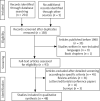Dermatomyositis and/or polymyositis as a paraneoplastic manifestation of ovarian cancer: a systematic review
- PMID: 33531873
- PMCID: PMC7836281
- DOI: 10.5114/wo.2020.102814
Dermatomyositis and/or polymyositis as a paraneoplastic manifestation of ovarian cancer: a systematic review
Abstract
Dermatomyositis (DM) is defined as an autoimmune inflammatory disease that affects the skin, the blood vessels and the muscles. It typically presents with erythema affecting mostly the eyes and the hands as well as proximal muscle weakness. It has been also correlated with various types of cancer, including ovarian cancer. A systematic PubMed and Scopus search was conducted. A total of 110 women were included in our review. The median age of the patients was 52.5 years (8-85). The most frequent histological type of malignancy was epithelial (87 cases, 79.1%) and in only one patient (0.9%) DM was co-existing with a cancer recurrence. A clinical diagnosis of DM or PM preceded the diagnosis of ovarian cancer in 69.1% (76/110), while paraneoplastic DM after the diagnosis of ovarian cancer was reported in 31% (34/110). Serum antibodies were present in 22.5% (25/110) and the median creatine kinase during first evaluation was 886 (56.6-16,596). Postoperative improvement of the symptoms was observed in 24.6% (27/110) while also 24.6% (27/110) needed post-treatment rheumatological management. Neoadjuvant chemotherapy or radiotherapy was necessary in 58.2% (64/110) and a cancer recurrence was identified in 28.2% (31/110), with a median follow up of 24.5 months (5-210). Finally, 52 (47.3%) deaths were reported in a median follow-up period of 16 months (0-210). It is crucial that DM patients should receive a thorough evaluation for ovarian cancer, among other malignancies, encompassing an abdominal CT or MRI scan and serum Ca-125 marker measurements. Treatment of ovarian cancer is usually accompanied by remission of DM symptoms in most of the cases.
Keywords: dermatomyositis; ovarian cancer; paraneoplastic syndrome; polymyositis.
Copyright © 2020 Termedia.
Conflict of interest statement
The authors declare no conflict of interest.
Figures
Similar articles
-
Paraneoplastic dermatomyositis associated with urothelial cancer: report of a case and systematic review of the literature.Front Oncol. 2023 Oct 31;13:1223627. doi: 10.3389/fonc.2023.1223627. eCollection 2023. Front Oncol. 2023. PMID: 38023222 Free PMC article. Review.
-
[18F]FDG uptake in proximal muscles assessed by PET/CT reflects both global and local muscular inflammation and provides useful information in the management of patients with polymyositis/dermatomyositis.Rheumatology (Oxford). 2013 Jul;52(7):1271-8. doi: 10.1093/rheumatology/ket112. Epub 2013 Mar 11. Rheumatology (Oxford). 2013. PMID: 23479721
-
[Polymyositis, dermatomyositis and inclusion body myositis, nosological aspects].Presse Med. 2003 Oct 25;32(35):1656-67. Presse Med. 2003. PMID: 14631270 Review. French.
-
Routine vs extensive malignancy search for adult dermatomyositis and polymyositis: a study of 40 patients.Arch Dermatol. 2002 Jul;138(7):885-90. doi: 10.1001/archderm.138.7.885. Arch Dermatol. 2002. PMID: 12071815
-
Predicting factors of malignancy in dermatomyositis and polymyositis: a case-control study.Br J Dermatol. 2001 Apr;144(4):825-31. doi: 10.1046/j.1365-2133.2001.04140.x. Br J Dermatol. 2001. PMID: 11298544
Cited by
-
Thigh Muscle MRI Edema Features of Dermatomyositis Patients With Ovarian Cancer: A Report of Three Cases.Cureus. 2022 Apr 21;14(4):e24337. doi: 10.7759/cureus.24337. eCollection 2022 Apr. Cureus. 2022. PMID: 35475251 Free PMC article.
-
Paraneoplastic dermatomyositis associated with urothelial cancer: report of a case and systematic review of the literature.Front Oncol. 2023 Oct 31;13:1223627. doi: 10.3389/fonc.2023.1223627. eCollection 2023. Front Oncol. 2023. PMID: 38023222 Free PMC article. Review.
-
Are Poly (ADP-Ribose) Polymerase Inhibitors Safe in Paraneoplastic Dermatomyositis due to High-Grade Serous Carcinoma of the Ovary? A Case Report and a Review of the Literature.Case Rep Oncol. 2025 May 29;18(1):878-884. doi: 10.1159/000546665. eCollection 2025 Jan-Dec. Case Rep Oncol. 2025. PMID: 40611884 Free PMC article.
References
-
- Iavazzo C, Vorgias G, Papadakis M, Manikis P, Mavromatis I, Akrivos T. Polymyositis in a patient with recurring ovarian cancer and history of unrelated breast cancer. Arch Gynecol Obstet 2007; 276: 81-84. - PubMed
-
- Gkegkes ID, Minis EE, Iavazzo C. Dermatomyositis and colorectal cancer: a systematic review. Ir J Med Sci 2018; 187: 615-620. - PubMed
Publication types
LinkOut - more resources
Full Text Sources
Research Materials
Miscellaneous

